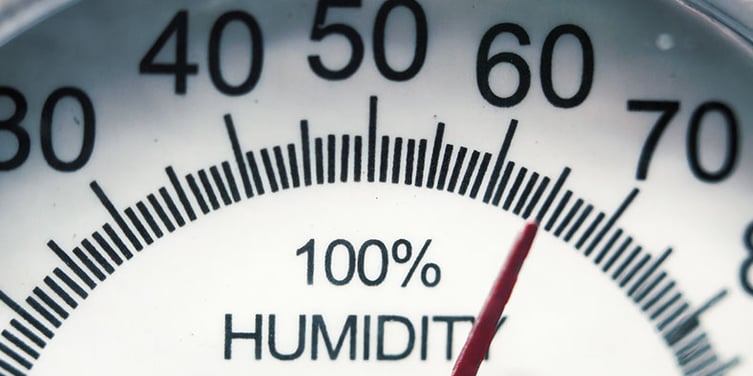
Humidity is an environmental condition that is often overlooked, but it is as important to facility management as temperature. This post is the first in our Know Your Environmental Threat series. It discusses how humidity monitoring is used to protect valuable assets in a variety of applications: HVAC, Greenhouses, Data Centers and Cannabis Growing Facilities.
Heating, Ventilation, Air Conditioning (HVAC)
Humidity control works hand in hand with temperature control to ensure the comfort of building occupants. For guidance on optimal humidity levels, facility managers turn to the American Society of Heating, Refrigerating and Air-Conditioning Engineers (ASHRAE). ASHRAE recommends a humidity level of 41.9 °F dew point to 60% relative humidity (RH), with an allowable range between 20-80%.
However, the ideal humidity range varies according to the type of facility. Comfort is the main goal for hotels, restaurants, office buildings, entertainment venues and other places where people gather. For that reason, it is important for facility managers to know if humidity readings are too high or low. Other buildings like hospitals, data centers and greenhouses, have very specific humidity requirements. Controlling humidity is also important when storing inventory, products and other assets.
Humidity can be very temperamental. Low humidity causes static electricity to discharge constantly. This can wear and damage electrical equipment and ruin computer components like RAM drives, CPUs, motherboards, and hard drives. Sparks of static electricity can also ignite flammable materials like dust, chemicals, and oxygen, causing explosions.
High humidity is not good either. It can lead to the growth of toxic mold, slippery floors and slick surfaces that endanger employees and visitors. It also causes condensation that corrodes equipment and machinery components, causing to downtime and repairs.
The only way to maintain correct humidity levels is to use a quality system to monitor humidity from 0-100%. Placing humidity sensors throughout your facility will provide the information required to detect HVAC equipment issues before they become expensive problems.
We recommend the following sensors to provide real-time data that triggers your monitoring system to send an alert when readings exceed your pre-set range.
- Duct Mount - These humidity sensors are should be mounted in a return air duct. They monitor relative humidity from 0% to 100%.
- Outdoor - These humidity sensors are designed to monitor relative humidity in harsh locations. They come in rugged, weatherproof enclosures, so that they can be used in processing plants and manufacturing facilities.
- Dew point - These sensors measure the temperature at which the humidity in the air will condense. Dew point is crucial in dehumidification systems in environments like manufacturing plants. It is also critical in refineries that require dry air to prevent rusting and fouling of actuators and sensors. Dew point sensors also have weatherproof enclosures to protect them from harsh environments.
Data Centers
Data center managers are extremely focused on preventing cyber threats, but physical dangers can also damage equipment and shut down operations. Humidity is one environmental hazard to watch out for.
Humidity fluctuations often result from a faulty cooling unit or HVAC system. Uncontrolled temperature and ventilation problems can also change humidity levels. If you’re using an air-side economizer system, you also need to humidify or dehumidify the air which brings cold air in from the outside to cool the data center.
It’s important to keep humidity within a safe range. As discussed above, too much moisture in the air can corrode equipment components, while low humidity can create electrostatic discharge (ESD) that can cause catastrophic failure of critical electronic components. ESD can also cause latent defects where equipment might continue to perform at a diminished level before it stops working.
ASHRAE recommends testing the data center atmosphere twice a year to detect the level of corrosion-causing pollutants in the air. Airborne pollutants like sulfide and oxide can cause printed circuit boards to corrode and fail.
The level of corrosion is linked to relative humidity. ASHRAE recommends keeping relative humidity at 70% when low levels of corrosion are detected on the test material. For high corrosion levels, they recommend a relative humidity level below 50% and they recommend maintaining 60% or lower relative humidity if the recommended tests were not conducted.
A remote monitoring system like our rack-mounted IMS-4000E is the best way to maintain ideal humidity levels. It is connected to humidity sensors throughout your server rooms and data centers. The system works around the clock and will alert personnel when the humidity level falls out of the desired range. Sensaphone suggests humidity sensor placement:
- One for every 5 racks
- Near each return
- Near the humidity control system
Greenhouses
Humidity directly affects plant photosynthesis and transpiration, so controlling humidity is crucial in the greenhouse environment. Depending on the crop, proper humidity levels are typically maintained between 40-85% RH.
Low humidity levels mean the air contains less water vapor, causing plants to lose moisture quicker during the inhalation of carbon dioxide during photosynthesis. During the transpiration process, the pores on a plant’s leaves open and take in carbon dioxide. Moisture escapes at a higher rate when the air around the plant is drier. When this occurs faster than the root system can send water to the plants leaves, the plant shuts down and dries out. Misters, foggers and humidifiers help raise humidity levels.
High humidity levels also negatively impact transpiration. When plants absorb water and minerals from the soil through their roots, transpiration assists these nutrients to the leaves.
If the moisture content within the air is too high, the process slows down, preventing the proper absorption of nutrients. Without the release of moisture, plants lose their ability to cool themselves. High humidity also aids the growth of mold and fungal diseases. Ventilation fans, dehumidifiers and opening greenhouse vents lower humidity levels.
Remote monitoring systems observe humidity levels 24/7. They can also monitor pumps, power, soil moisture content, pressure lines on your misters and controller alarm faults from a single unit. Greenhouse sensors also impact plant growth. The 4-20mA Type Outdoor Humidity Transmitter is able to detect humidity levels between 0 and 100% RH. Users set a high and low threshold that will activate an alarm in the Sensaphone system when the threshold is crossed.
Cannabis Growing
In order to thrive, cannabis plants need extremely specific environmental conditions. Minute changes in humidity can impede their growth and potency. High relative humidity (RH) encourages mold and fungus growth, but low RH slows the photosynthetic process. The optimum humidity level for each plant changes with their growth stage. Seedlings and cuttings thrive with a higher humidity, while more mature plants grow best with a lower humidity.
Cannabis growers raise their crops in controlled environments to maintain optimal growing conditions. Remote monitoring systems provide an extra line of defense by continuously monitoring the humidity in the facility.
No matter what your indoor environment, chances are that humidity has not been identified as a major threat, but it can make workers and visitors uncomfortable and can quietly harm equipment and assets. It is easy and inexpensive to avoid these effects by installing a remote monitoring system. Be sure to look out for our next Know Your Environmental Threat blog post for more tips on protecting your equipment, products and services.
To learn how you can select or upgrade a monitoring system at your facility, contact a Sensaphone expert today
.








